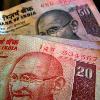

:Throughout this article, the unqualified term "dollar" and the $ symbol refer to the US dollar.
The economy of India is the eleventh largest (List of countries by GDP (nominal)) economy in the world by nominal GDP (gross domestic product). and the fourth largest (List of countries by GDP (PPP)) by purchasing power parity (List of countries by GDP (PPP)) (PPP). In the 1990s, following economic reform from the socialist-inspired economy of post-independence India, the country began to experience rapid economic growth, as markets opened for international competition and investment. In the 21st century, India is an emerging economic power with vast human and natural resources, and a huge knowledge base. Economists predict that by 2020, India will be among the leading economies of the world.
India was under social democratic-based policies from 1947 to 1991. The economy was characterised by extensive regulation (License Raj), protectionism, and public ownership, leading to pervasive corruption (Corruption in India) and slow growth (Hindu rate of growth). Since 1991, continuing economic liberalisation (Economic liberalisation in India) has moved the economy towards a market-based system (market economy). A revival of economic reforms and better economic policy in 2000s accelerated Indias economic growth rate (economic development in India). By 2008, India had established itself as the worlds second-fastest growing major economy (List of countries by GDP (real) growth rate). However, the year 2009 saw a significant slowdown in Indias official GDP growth rate to 6.1% as well as the return of a large projected fiscal deficit of 6.8% of GDP which would be among the highest in the world.
Indias large service industry accounts for 62.6% of the countrys GDP while the industrial and agricultural sector contribute 20% and 17.5% respectively. Agriculture (Agriculture in India) is the predominant occupation in India, accounting for about 52% of employment. The service (service (economics)) sector makes up a further 34%, and industrial sector around 14%. The labor force totals half a billion workers (Labour in India). Major agricultural products (product (business)) include rice, wheat, oilseed, cotton, jute, tea, sugarcane, potatoes, cattle, water buffalo, sheep, goats, poultry and fish. Major industries include telecommunications, textiles, chemicals, food processing, steel, transportation equipment, cement, mining, petroleum, machinery, information technology enabled services and software (computer software).
Indias per capita income (nominal) is $1,030, ranked 139th (List of countries by GDP (nominal) per capita) in the world, while its per capita (PPP) of US$2,940 is ranked 128th (List of countries by GDP (PPP) per capita). Previously a closed economy, Indias trade has grown fast. India currently accounts for 1.5% of World trade as of 2007 according to the WTO. According to the World Trade Statistics of the WTO in 2006, Indias total merchandise trade (counting exports and imports) was valued at $294 billion in 2006 and Indias services trade inclusive of export and import was $143 billion. Thus, Indias global economic engagement in 2006 covering both merchandise and services trade was of the order of $437 billion, up by a record 72% from a level of $253 billion in 2004. Indias trade has reached a still relatively moderate share 24% of GDP in 2006, up from 6% in 1985.
Currency: 1 Indian Rupee (INR) (?) = 100 Paise (Paisa)
Organs: WTO (World Trade Organization), SAFTA (South Asian Free Trade Area), G-20 (G20 major economies) and others
Rank: 12th
Gdp: $1.236 trillion (2009) (nominal; 11th (List of countries by GDP (nominal))) $3.526 trillion (2009) (PPP; 4th (List of countries by GDP (PPP)))
Growth: 7.4% (2009/2010)
Per Capita: $1,030 (2009) (nominal; 139th (List of countries by GDP (nominal) per capita)) $2,940 (2009) (PPP; 128th (List of countries by GDP (PPP) per capita))
Sectors: agriculture (17.5%), industry (20%), services (62.6%) (2009 est.)
Inflation: 9.9% (Mar. 2010), Food inflation (17.7%) (Mar. 2010)
Gini: 36.8 (List of countries (List of countries by income equality))
Labor: 467 million (2009 est.) (2nd (List of countries by labour force))
Occupations: agriculture (52%), industry (14%), services (34%) (2003)
Unemployment: 9.5% (2009 est.)
Exports: $155 billion f.o.b (2009 est.)
Export-goods: software, petroleum products, textile goods, gems and jewelry, engineering goods, chemicals, leather manufactures
Export-partners: US (United States) 12.3%, UAE (United Arab Emirates) 9.4%, China (People's Republic of China) 9.3% (2008)
Imports: $232.3 billion f.o.b (2009 est.)
Import-goods: crude oil, machinery, gems, fertilizer, chemicals
Import-partners: China (People's Republic of China) 11.1%, Saudi Arabia 7.5%, US (United States) 6.6%, UAE (United Arab Emirates) 5.1%, Iran 4.2%, Singapore 4.2%, Germany 4.2% (2008)
Fdi: $156.30 billion (31 December 2009 est.)
Debt: $163.8 billion (2009) 60.1% of GDP
Gross External Debt: $232.5 billion (31 December 2009 est.)cite weburl=debt goes up marginally to $228 bnpublisher=Economic Times
Revenue: $153.5 billion (2008 est.)
Expenses: $223 billion (2009 est.)
Aid: $1.724 billion (2005)
Reserves: $287.37 billion (end-Dec 2009) (5th (List of countries by foreign exchange reserves))
Cianame: in
Spelling: Oxford

